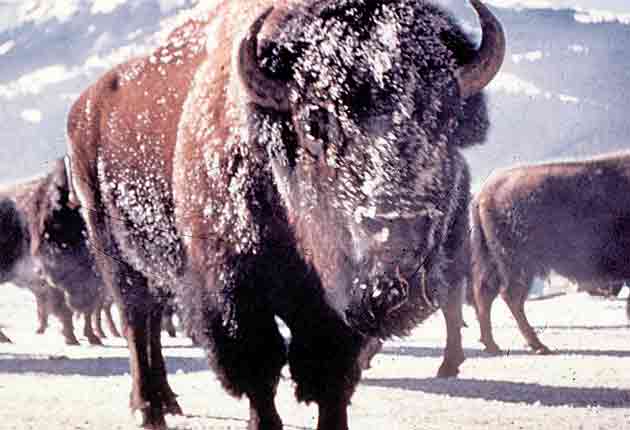Yellowstone's roaming buffalo stray into trouble

Your support helps us to tell the story
From reproductive rights to climate change to Big Tech, The Independent is on the ground when the story is developing. Whether it's investigating the financials of Elon Musk's pro-Trump PAC or producing our latest documentary, 'The A Word', which shines a light on the American women fighting for reproductive rights, we know how important it is to parse out the facts from the messaging.
At such a critical moment in US history, we need reporters on the ground. Your donation allows us to keep sending journalists to speak to both sides of the story.
The Independent is trusted by Americans across the entire political spectrum. And unlike many other quality news outlets, we choose not to lock Americans out of our reporting and analysis with paywalls. We believe quality journalism should be available to everyone, paid for by those who can afford it.
Your support makes all the difference.One errant cow has been euthanised already, but wildlife officials continued to insist yesterday that a controversial experiment to allow American buffalo to stray for the first time in decades out of Yellowstone National Park and onto public lands in Montana is still on track.
Debate has flared again over the fate of the American buffalo – also known as bison – after park managers herded a small group of 25 cows and bulls out of Yellowstone and into Montana earlier this month, in the hope that they would spend the rest of the winter on 2,500 acres of public forest land there.
The federal government is driven by nostalgia to protect the bison in Yellowstone and give them greater freedom to roam. Once a symbol of the American west , the bison nearly became extinct in the early 20th century, when hunting and disease cut their numbers from millions to about fifty.
But bison are prone to contracting brucellosis, a disease that leads cattle to abort their young. Ranchers in Montana are therefore historically opposed to any relaxing of measures that have so far kept the surviving animals inside the park, where, alongside bears, they have become a big tourist draw.
It is no surprise that the driving of 25 bison onto Montana lands by rangers riding on horses and four-wheel-drive buggies just over a week ago has drawn such intense scrutiny. Things started go to awry last weekend when about 15 of the animals decided they would be happier on the other side of a road dividing the public lands from a private ranch. The cow was shot dead when she refused all attempts to drive her back.
"They couldn't get her turned around so they had to lethally remove her," Steve Merritt, a spokesman for the Montana Department of Livestock, confirmed, while downplaying the extent of the setback. "I don't think it changes the progress at all. This is an experiment. We had no idea what the bison were going to do once we got them up there. This is just a learning process ."
His boss, Ben McDonald, said a degree of non-cooperation from the animals was to be expected. "They're like little kids, they do just the opposite of what you tell them," he said. "A bison has a mind of its own at times."
Some animal rights lobbyists suggested the rangers were naïve thinking the beasts would stay on the forest lands. "They thought the buffalo would stay in this little magic area designated for them and buffalo don't tend to do that," said Dan Brister, head of Buffalo Field Campaign.
The bison led into Montana had all tested negative for brucellosis before being separated from a larger group of more than 80 animals that have been kept in a corral in the north of Yellowstone for several months. The rest were released from the corral on Thursday and drivendeeper into the park.
"We're glad they made the right decision. It's a real victory for the bison," Mr Brister said. Not all the animals driven deeper into the park had been tested for brucellosis. Rangers at Yellowstone have estimated that about half the bison there have been exposed to the disease and of those half have been infected.
Keeping brucellosis out of Montana is considered crucial by its cattle ranchers. For now the state has been certified free of the disease and its livestock can be sold across state borders without testing or controls. Any change in that status could drive down the value of animals on Montana's huge ranches.
Join our commenting forum
Join thought-provoking conversations, follow other Independent readers and see their replies
Comments